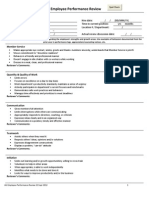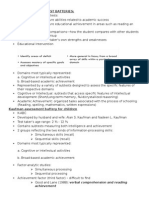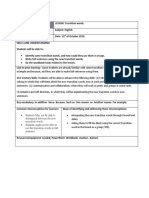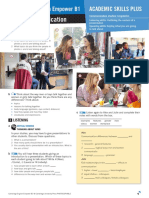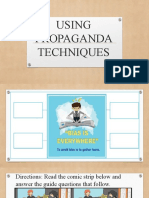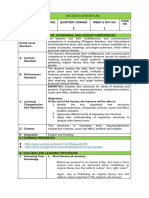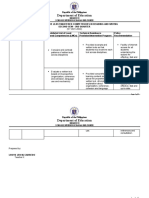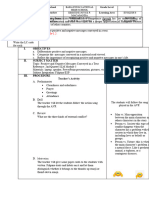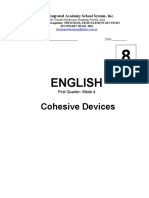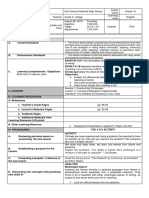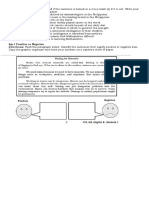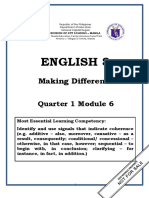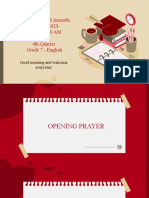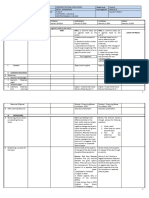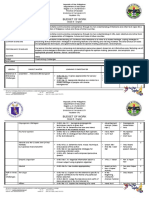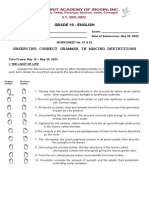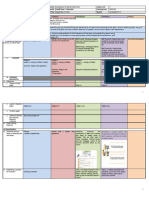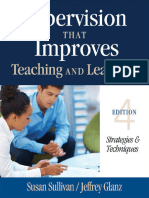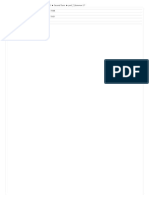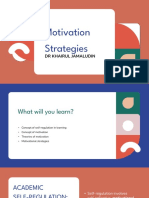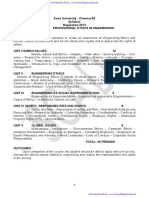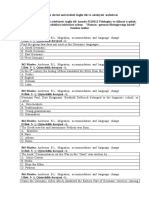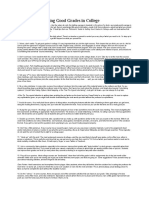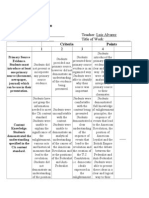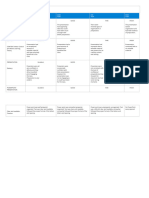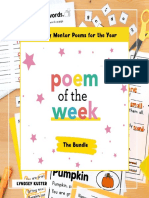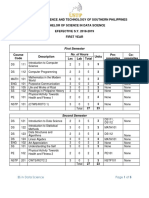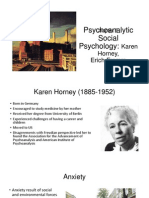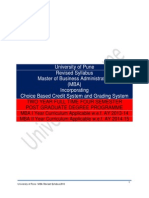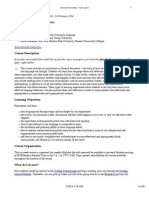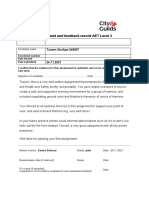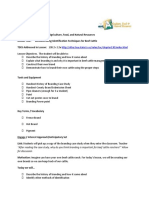0 ratings0% found this document useful (0 votes)
78 viewsG7-DLL - 1 (06.25-29.18.)
G7-DLL - 1 (06.25-29.18.)
Uploaded by
GraciaThis document contains a daily lesson log for an English class in Grade 7 at Baguio City National High School from June 25-29, 2018. The lessons covered colloquial language, slang, stress, intonation, and word webs. On different days, students learned to distinguish features of colloquial language and slang, give examples, and practice related skills. Assessment included a summative test on Friday to evaluate student understanding of concepts covered during the week.
Copyright:
© All Rights Reserved
Available Formats
Download as DOCX, PDF, TXT or read online from Scribd
G7-DLL - 1 (06.25-29.18.)
G7-DLL - 1 (06.25-29.18.)
Uploaded by
Gracia0 ratings0% found this document useful (0 votes)
78 views3 pagesThis document contains a daily lesson log for an English class in Grade 7 at Baguio City National High School from June 25-29, 2018. The lessons covered colloquial language, slang, stress, intonation, and word webs. On different days, students learned to distinguish features of colloquial language and slang, give examples, and practice related skills. Assessment included a summative test on Friday to evaluate student understanding of concepts covered during the week.
Original Description:
Daily Lesson Log - Grade 7 - First Quarter
Original Title
G7-DLL_1 (06.25-29.18.)
Copyright
© © All Rights Reserved
Available Formats
DOCX, PDF, TXT or read online from Scribd
Share this document
Did you find this document useful?
Is this content inappropriate?
This document contains a daily lesson log for an English class in Grade 7 at Baguio City National High School from June 25-29, 2018. The lessons covered colloquial language, slang, stress, intonation, and word webs. On different days, students learned to distinguish features of colloquial language and slang, give examples, and practice related skills. Assessment included a summative test on Friday to evaluate student understanding of concepts covered during the week.
Copyright:
© All Rights Reserved
Available Formats
Download as DOCX, PDF, TXT or read online from Scribd
Download as docx, pdf, or txt
0 ratings0% found this document useful (0 votes)
78 views3 pagesG7-DLL - 1 (06.25-29.18.)
G7-DLL - 1 (06.25-29.18.)
Uploaded by
GraciaThis document contains a daily lesson log for an English class in Grade 7 at Baguio City National High School from June 25-29, 2018. The lessons covered colloquial language, slang, stress, intonation, and word webs. On different days, students learned to distinguish features of colloquial language and slang, give examples, and practice related skills. Assessment included a summative test on Friday to evaluate student understanding of concepts covered during the week.
Copyright:
© All Rights Reserved
Available Formats
Download as DOCX, PDF, TXT or read online from Scribd
Download as docx, pdf, or txt
You are on page 1of 3
GRADE 1 to 12 School Baguio City National High School Grade Level Grade 7
DAILY LESSON LOG Teacher Christine Grace D. Gonzales Learning Area English
Date/Time June 25 -29, 2018 (10:00-11:00AM/11:00-12:00PM) Quarter First (Lesson 1: Valuing Our Elders Wisdom)
Monday Tuesday Wednesday Thursday Friday
June 25, 2018 June 26, 2018 June 27, 2018 June 28, 2018 June 29, 2018
I. OBJECTIVES
A. Content Standards The learner demonstrates understanding of: pre-colonial Philippine literature as a means of connecting to the past; various reading styles; ways of determining word meaning;
the sounds of English and the prosodic features of speech; and correct subject-verb agreement.
B. Performance Standards The learner transfers learning by: showing appreciation for the literature of the past; comprehending texts using appropriate reading styles; participating in conversations using
appropriate context-dependent expressions; producing English sounds correctly and using the prosodic features of speech effectively in various situations; and observing correct
subject-verb agreement.
C. Learning Competencies / EN7V-I-a-22.1: EN7V-I-a-22: EN7F-Ia-3.11: Demonstrate confidence and EN7SS-I-e-1.2:
Objectives Distinguish features of colloquial Distinguish between slang and Observe the correct production honesty in answering the test. Transcode orally and in writing
language (fillers, contractions, colloquial expressions in of vowel and consonant sounds, the information presented in
etc.) and slang. conversations. diphthongs, blends, glides, etc. diagrams, charts, table, graphs,
Distinguish features of Give the slang equivalent of Distinguish the heteronyms etc.
colloquial language and slang. colloquial expressions and vice based on stressed syllables of Demonstrate understanding of
Identify sentences as colloquial versa. words. the text read.
language and slang. Make a short dialogue EN7LC-I-b-5.2: Present concepts and ideas
Use synonyms and antonyms containing colloquial language Note the changes in stress and using word webs.
of words to form colloquial and slang. intonation that affect meaning.
language and slang. Define stress and intonation.
Demonstrate the appropriate
purpose or feeling in an
utterance.
Direct Instruction Interactive Instruction Experiential Instruction Direct Instruction
II. CONTENT Colloquial and Slang Colloquial and Slang Stress and Intonation Summative Assessment 1 Word Webs
(Synonym and Antonym)
III. LEARNING RESOURCES
A. References
1. Teacher’s Guide pages 22 22
2. Learner’s Materials 27 22-25 31-32, 52-54
pages
3. Textbook pages
4. Additional Materials
from Learning Resource
(LR) portal
B. Other Learning Resources Activity Sheets Audio in Heteronyms Summative Test Sheets Story: The Legend of Maria
Makiling
IV. PROCEDURES
A. Reviewing previous lesson Ask: What did we do in the Ask students to define colloquial Let the students do spelling. Conduct a short review for the Show a picture of Maria Makiling.
or presenting the new previous meeting? What did language and slang. Let the summative assessment. Ask: Do you know her story?
lesson we learn in the previous students state the features of How do we better understand
meeting? colloquial language and slang. her story?
Review synonyms and
antonyms. Present a list of
words in pairs. Let the
Page 1 of 3
students identify whether the
pairs are synonyms or
antonyms. Discuss the
answers with the students.
B. Establishing a purpose for Present the objectives of the Present the objectives of the Present the objectives of the Remind the students how they Present the objectives of the
the lesson lesson. lesson. lesson. should behave when answering lesson.
tests.
C. Presenting Let the students read and Let the students give their own Show samples of word webs.
examples/instances of the identify the examples of examples of colloquial language
new lesson colloquial language and slang. and slang through recitation.
D. Discussing new concepts Give features of colloquial Let the students do the activity Define stress. Let the students Let the students understand why
and practicing new skills language and slang. Let the on giving the slang equivalent of listen to an audio of heteronyms. and how we use word webs.
#1 students give their own colloquial expressions and vice Let the students repeat and
examples through recitation. versa. remember the right stress to
distinguish heteronyms.
E. Discussing new concepts Define intonation. Let the
and practicing new skills students demonstrate the right
#2 intonation to achieve the
purpose and feeling of the
sentences.
F. Developing mastery
G. Finding practical Let the students realize that Let the students realize that Let the students state the Let the students realize that
applications of concepts synonyms and antonyms help colloquial language and slang are importance of stress and word webs help in enriching
and skills in daily living widen one’s vocabulary and used in everyday speech. They intonation in expressing one’s one’s vocabulary.
make communication (colloquial reflect one’s relationship with feelings and purpose.
language and slang) more other people.
interesting.
H. Making generalizations Present summary of the lesson Present summary of the lesson Present summary of the lesson. Present summary of the lesson.
and abstractions about through a table. through a venn diagram.
the lesson
I. Evaluating learning Let the students rewrite the Instruct the students to make a Let the students answer the Let the students answer the Give an overview about The
colloquial language and slang short dialogue containing activity on stress and intonation. summative test consisting of Legend of Maria Makiling. Let the
using the underlined word’s colloquial language and slang. The students identify the questions and activities on the students read The Legend of
synonym and antonym. The dialogue will be scored stressed syllables of heteronyms topics discussed in Lesson 1. Maria Makiling. Task the students
according to content, language, and the purpose/feeling of the to create a word web by
and comprehensibility. sentence. identifying the unfamiliar words
from the legend and expand on
it by giving synonyms, antonyms,
and examples.
J. Additional activities for
application or remediation
V. REMARKS
VI. REFLECTION
A. No. of learners who
earned 80% in the
evaluation.
B. No. of learners who
require additional
activities for remediation
Page 2 of 3
who scored below 80%
C. Did the remedial lessons
work? No. of learners who
have caught up with the
lesson.
D. No. of learners who
continue to require
remediation
E. Which of my teaching
strategies worked well?
Why did these work?
F. What difficulties did I
encounter which my
principal or supervisor can
help me solve?
G. What innovation or
localized materials did I
use/discover which I wish
to share with other
teachers?
Page 3 of 3
You might also like
- AU Employee Performance Review - HourlyDocument2 pagesAU Employee Performance Review - Hourlykingsman6100% (1)
- Psychoeducational Test Batteries - HosDocument3 pagesPsychoeducational Test Batteries - HosMarjorie Villarosa100% (1)
- DLP-8-Q1mODULE-5-Remefe SolamilloDocument5 pagesDLP-8-Q1mODULE-5-Remefe SolamilloKristell C. Lagarde100% (1)
- Lesson Plan2 - Transition WordsDocument5 pagesLesson Plan2 - Transition Wordsapi-490333191100% (1)
- Empower B1 Academic Skills StudentsDocument32 pagesEmpower B1 Academic Skills StudentsLuis Felipe Villamarín GranjaNo ratings yet
- DLP.A Grade 10Document9 pagesDLP.A Grade 10cecilynNo ratings yet
- Lesson Plan in ModalsDocument9 pagesLesson Plan in ModalsArrabela D.C. AngelesNo ratings yet
- EN8SS-IIIg-1 6 4 - LP3Document9 pagesEN8SS-IIIg-1 6 4 - LP3FLORES RODENBEBSNo ratings yet
- Division Training On Literacy Instruction: Cuasito, Alfie Marquez - Malamawi NhsDocument3 pagesDivision Training On Literacy Instruction: Cuasito, Alfie Marquez - Malamawi NhsAlfie CuasitoNo ratings yet
- English 8 Lesson PlanDocument6 pagesEnglish 8 Lesson PlanANNABEL PALMARINNo ratings yet
- Propaganda Techniques g8Document21 pagesPropaganda Techniques g8Shicheese MinaNo ratings yet
- Localized PlanDocument20 pagesLocalized PlanJAYZEL MARIZ MONTEJONo ratings yet
- DLP - Cot 1Document4 pagesDLP - Cot 1Patricia Carla UndangNo ratings yet
- Teaching-Guide-Catchup-English 8Document2 pagesTeaching-Guide-Catchup-English 8Mayette Danias MondaloNo ratings yet
- DLL Eng8 Week5 Using Transistion SignalsDocument4 pagesDLL Eng8 Week5 Using Transistion SignalsPRECITA PELONIANo ratings yet
- Module 1 DLP - AnalogyDocument7 pagesModule 1 DLP - AnalogyJuna AlgonesNo ratings yet
- ENGLISH 8 SECOND QUARTER Module 2Document19 pagesENGLISH 8 SECOND QUARTER Module 2keziahNo ratings yet
- Quiz Opinion Marking SignalsDocument2 pagesQuiz Opinion Marking SignalsJ. M.No ratings yet
- Lesson Plan in Grade 8 Positive NegativeDocument7 pagesLesson Plan in Grade 8 Positive Negativejessa.solano001No ratings yet
- Day 2 (Week 3 LP) - Moral IssuesDocument3 pagesDay 2 (Week 3 LP) - Moral IssuesMaria Angela EduardoNo ratings yet
- Learning Activity Sheet in English 8: A. Most Essential Learning CompetencyDocument8 pagesLearning Activity Sheet in English 8: A. Most Essential Learning CompetencyMaricel sinfuegoNo ratings yet
- Detailed Lesson Plan Pa CheckDocument9 pagesDetailed Lesson Plan Pa Checkondejohnpaul4No ratings yet
- English: Quarter 3 Module 2b: Using A Variety of Persuasive and Argumentative Writing TechniquesDocument20 pagesEnglish: Quarter 3 Module 2b: Using A Variety of Persuasive and Argumentative Writing TechniquesPaola Pelle Rosal0% (1)
- English 8 Q2 WK5Document23 pagesEnglish 8 Q2 WK5Mai Mai ResmaNo ratings yet
- Least-Learned-Competencies-Reading and WritingDocument2 pagesLeast-Learned-Competencies-Reading and WritingLhoyd Jen CarredoNo ratings yet
- Lesson Plan in English 8 - DEMODocument6 pagesLesson Plan in English 8 - DEMOmc bern00No ratings yet
- Quarter 1 Module 2: Genres of ViewingDocument53 pagesQuarter 1 Module 2: Genres of ViewingJohn Edmark TelesforoNo ratings yet
- Classroom ObservationDocument5 pagesClassroom Observationkristine joyce macagandaNo ratings yet
- Eng8 Q1 W4 EDITEDDocument14 pagesEng8 Q1 W4 EDITEDEmmy Lou Gonzales PilarNo ratings yet
- Analyzing Intention of Words or Expressions Used in Propaganda TechniquesDocument6 pagesAnalyzing Intention of Words or Expressions Used in Propaganda TechniquesErica TappaNo ratings yet
- August 6, 2019Document4 pagesAugust 6, 2019Annie AriagaNo ratings yet
- ENGLISH-8-Quarter 2-Week 5Document6 pagesENGLISH-8-Quarter 2-Week 5Duero-Hadjilatip Kaye100% (1)
- When Wine Is Ripe WorksheetDocument1 pageWhen Wine Is Ripe WorksheetJenny Rose Sumagaysay - Baldado88% (8)
- Worksheets - Long Test For ENGLISH 8 - BIAS TOPICDocument2 pagesWorksheets - Long Test For ENGLISH 8 - BIAS TOPICChrisAnnCabradillaNo ratings yet
- LP 7e's #1 - G10Document2 pagesLP 7e's #1 - G10rosemie olimNo ratings yet
- English 10 First Quarter Week 7Document4 pagesEnglish 10 First Quarter Week 7Vince Rayos Cailing100% (1)
- 4Q Eng8 Lesson 4 PDFDocument27 pages4Q Eng8 Lesson 4 PDFMariz Agustin100% (1)
- English DLL 2ND Quarter Week 6 Different Claims, ExpositionDocument4 pagesEnglish DLL 2ND Quarter Week 6 Different Claims, ExpositionRocky James SarasuaNo ratings yet
- MODULE-4 (Aira Day 1)Document4 pagesMODULE-4 (Aira Day 1)Maria Angela EduardoNo ratings yet
- Pliant Like The Bamboo - Worksheet No.4Document1 pagePliant Like The Bamboo - Worksheet No.4JoyjosephGarvidaNo ratings yet
- English 7Document3 pagesEnglish 7Djoana Rose Hiponia JunsayNo ratings yet
- RAT English 8Document11 pagesRAT English 8Dennis NuevoNo ratings yet
- DLP Eng8 Q1 M4Document8 pagesDLP Eng8 Q1 M4hartchieNo ratings yet
- Engl 8 Summative OpinionDocument1 pageEngl 8 Summative OpinionAngie LeeNo ratings yet
- Meaning-Making Using Visuals or Graphs As Form of Multimodal TextsDocument29 pagesMeaning-Making Using Visuals or Graphs As Form of Multimodal TextsAlpha Joy ProvidoNo ratings yet
- ENGLISH 8 - Q1 - Mod6 - Emphassis Markers...Document12 pagesENGLISH 8 - Q1 - Mod6 - Emphassis Markers...Monica PolicarpioNo ratings yet
- Transition Signals Lesson PlanDocument10 pagesTransition Signals Lesson Planjuvelyn abuganNo ratings yet
- Grade 8 DLP Lesson 2Document7 pagesGrade 8 DLP Lesson 2Vanessa R. AbadNo ratings yet
- 2ndobservation CO2Document28 pages2ndobservation CO2LJ Caylan BareteNo ratings yet
- English 8-Q4-M2 PDFDocument14 pagesEnglish 8-Q4-M2 PDFLorry ManuelNo ratings yet
- DLL G8Q3W1Document6 pagesDLL G8Q3W1rezamagdaraog.ckc.igsarNo ratings yet
- G8 English Budget of Work 3rd QuarterDocument4 pagesG8 English Budget of Work 3rd QuarterSean BustosNo ratings yet
- Melc DLL Eng 10 Week 7 q1 DoneDocument8 pagesMelc DLL Eng 10 Week 7 q1 DoneCheret LengNo ratings yet
- DLL-ENGLISH Q1 Week 1Document7 pagesDLL-ENGLISH Q1 Week 1RUSSEL JOY SUPERALESNo ratings yet
- Daplin Semi Detailed Lesson Plan in English 10Document5 pagesDaplin Semi Detailed Lesson Plan in English 10Genevieve DaplinNo ratings yet
- English 8 Module 2 4qDocument8 pagesEnglish 8 Module 2 4qjocelyn vergaraNo ratings yet
- Positive and Negative Messages Conveyed in A TextDocument59 pagesPositive and Negative Messages Conveyed in A TextTeacher MariconNo ratings yet
- Observing Correct Grammar in Making Definitions: Grade 10 - EnglishDocument3 pagesObserving Correct Grammar in Making Definitions: Grade 10 - EnglishJosan Balicoco0% (1)
- ST English 8 No. 1Document4 pagesST English 8 No. 1Roylyn Joy CarlosNo ratings yet
- English8 Q2 Mod2 OpinionMarkingSignals No-Key 2Document28 pagesEnglish8 Q2 Mod2 OpinionMarkingSignals No-Key 2cueco2michael203100% (1)
- Temporan National High School 7-Pearl Cyril A. Verdadero English 7 7:15-8:15 First Quarter, Week2 Monday Tuesday Wednesday Thursday FridayDocument4 pagesTemporan National High School 7-Pearl Cyril A. Verdadero English 7 7:15-8:15 First Quarter, Week2 Monday Tuesday Wednesday Thursday FridayCyril VerdaderoNo ratings yet
- 1.1 New DLL - English-6 - Q1 - W4Document11 pages1.1 New DLL - English-6 - Q1 - W4Malou RestonNo ratings yet
- DLL 2nd WeekDocument4 pagesDLL 2nd WeekJERALLI ROSE VALENCIA-HERNANDEZNo ratings yet
- Supervision That Improves Teaching and Learning Strategies Techniques (Susan S. Sullivan Jeffrey G. Glanz) (Z-Library)Document245 pagesSupervision That Improves Teaching and Learning Strategies Techniques (Susan S. Sullivan Jeffrey G. Glanz) (Z-Library)huyentrantt.workNo ratings yet
- Fruitful FundingDocument79 pagesFruitful FundingImprovingSupportNo ratings yet
- Pref - 7 - Grammar 2 PDFDocument4 pagesPref - 7 - Grammar 2 PDFjohanaNo ratings yet
- DMIT PresentationDocument26 pagesDMIT PresentationTusharrameshmane100% (3)
- Slide Strategi MotivasiDocument68 pagesSlide Strategi MotivasiEyka YanaNo ratings yet
- Ge6075 Scad MSM PDFDocument89 pagesGe6075 Scad MSM PDFlogamaniNo ratings yet
- Unit 2 My Home Lesson 1 Getting StartedDocument3 pagesUnit 2 My Home Lesson 1 Getting Startedhuytran08No ratings yet
- 2 5229179200354652442Document35 pages2 5229179200354652442frank franzyNo ratings yet
- Abrams Et AlDocument2 pagesAbrams Et AlThalia VladimirouNo ratings yet
- Intelligent Machines: An Introductory Perspective of Artificial Intelligence and RoboticsDocument2 pagesIntelligent Machines: An Introductory Perspective of Artificial Intelligence and RoboticsannieNo ratings yet
- 15 Secrets of Getting Good Grades in CollegeDocument2 pages15 Secrets of Getting Good Grades in CollegesagrvNo ratings yet
- Presentation RubricDocument2 pagesPresentation Rubricapi-238668238No ratings yet
- 6 Taking Charge of One's HealthDocument51 pages6 Taking Charge of One's HealthJavadd KilamNo ratings yet
- Group Presentation RubricDocument2 pagesGroup Presentation RubricJoanna Faye RodriguezNo ratings yet
- Causes of Academic Stress On Students by HassanDocument16 pagesCauses of Academic Stress On Students by HassanM Hassan Tunio100% (1)
- UCSPDocument6 pagesUCSPHannah FerreraNo ratings yet
- Monthly Mentor Poems For The Year: Lyndsey KusterDocument18 pagesMonthly Mentor Poems For The Year: Lyndsey KusterMichael Gift100% (2)
- The Responsible ManagerDocument2 pagesThe Responsible ManagerkrishnammdNo ratings yet
- Schwarzer 1991Document15 pagesSchwarzer 1991jpl.guedes6842No ratings yet
- Prospectus Bsds PDFDocument5 pagesProspectus Bsds PDFHomer Solon PadugaNo ratings yet
- Psychoanalytic Social Psychology:: Karen Horney, Erich FrommDocument15 pagesPsychoanalytic Social Psychology:: Karen Horney, Erich FrommnickcupoloNo ratings yet
- FM-HRD-001 - L-D-Proposal-Template Rev 01Document3 pagesFM-HRD-001 - L-D-Proposal-Template Rev 01EttenEhmjayeNo ratings yet
- MBA Syllabus 2013 CBCGS Pattern FinalDocument580 pagesMBA Syllabus 2013 CBCGS Pattern FinalGauravBulaniNo ratings yet
- General Semantics CourseDocument188 pagesGeneral Semantics Coursesiva.radha100% (3)
- New TIP Course 1 DepEd Teacher 1Document120 pagesNew TIP Course 1 DepEd Teacher 1Kaija AmadorNo ratings yet
- Assignment 1 AetDocument6 pagesAssignment 1 AetTazeen ShafNo ratings yet
- Beef Cattle Branding LPDocument3 pagesBeef Cattle Branding LPapi-316735868No ratings yet
